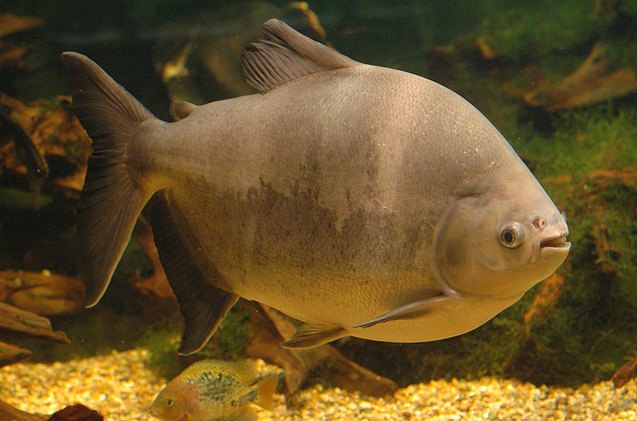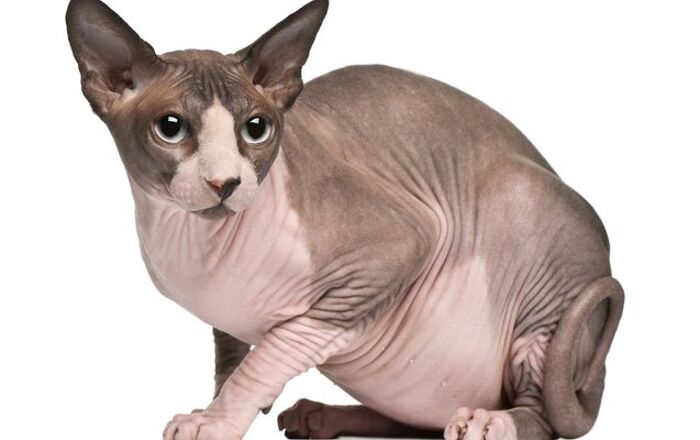
Pacu General description
Pacus are a large family of freshwater fish related to the Piranha. However, while some species of Pacu do look like Piranhas, they are actually herbivores and an extremely peaceful species of fish. One of the primary differences between the two is that the piranha’s teeth are triangular and razor sharp and the Pacu’s teeth are more square shaped and human-like. Additionally, most of the similarities these two species share end in maturity, especially size-wise. Pacus are also known to develop personalities as they grow older and can sometimes recognize their owners. Their fascinating behaviors make them a popular choice among aquaria enthusiasts.
However, the impressive size of these fishes makes them a good choice only for the experienced aquarists who can provide the care they require. An adult Pacu can be over 30 inches long and will need to be kept in a pond or an enormous tank. Even the two types of Pacu that are most commonly sold in pet stores, the Black Pacu and the Red-Bellied Pacu, will grow to this size.
In case you have a big aquarium or you are prepared to get one to keep your fish happy in their environment, read on. Pacu has a lot to offer to the right owner but they also have a few quirks and requirements that don’t make them a good match for everybody.
Pacu are a large family of freshwater fish related to the piranha.
Origins
Pacu fish originate from tropical and subtropical South America. Their natural habitat includes river, lakes and flooded forests, and spans from the depth of the Amazon to River Plate basin. However, despite the fact that their place of origin is South America, several species of Pacu can be found all over the world in the wild. This is the result of the illegal release of Pacu pet fish into the wild after the owners realize that they have grown too big for their tank. Now, there’s Pacu in the wild everywhere from the United States to Scandinavia, and in some areas, these aquarium fishes are becoming an invasive species and a threat to the ecosystem.
Color
Pacu family consists of many different species of fish. Naturally, this accounts for some variations in appearance, and it’s mainly colors that help experts make the distinction between different Pacu species. Not unlike most freshwater fishes, Pacu will also be a bit dull in comparison to their colorful tropical relatives. The main colors of their scales are the typical greyish olive, but the accent colors will depend on the particular species. For instance, the Black or Black-Finned Pacu will have a mainly black body, whereas the Red-Bellied Pacu sports a striking scarlet underside.
Maintenance and care

The most important thing that you need to know before deciding to raise pacu is that they are an extremely large species of fish. And contrary to popular belief, some species can reach over three feet in length no matter how confined their aquariums are. It is not uncommon for inexperienced aquarists to purchase and raise younger specimens only to realize that they cannot keep up with their great size and extremely demanding aquarium requirements over time. Pacus should ideally live in extremely large aquariums of 150 gallons or more or large outdoor ponds.
Care should be taken when decorating and maintaining your aquarium because they are known to use their powerful teeth to sometimes crush aquarium heaters and accessories. Pacu are extremely powerful and can sometimes knock glass lids off aquariums when excited. You should also be mindful of their size and power while you clean the tank. Although they are an extremely peaceful species, they are very inquisitive and have an extremely powerful bite. There are several reports of aquarists who have been severely injured from bites by inquisitive pacus.
As for the rest of their care requirements, Pacus are surprisingly undemanding. They feel good in water that has a pH value of 6.0 to 8.0. The temperature of the water should be around 75 to 81 degrees Fahrenheit. In other words, a basic simple freshwater aquarium setup will be a great fit for the Pacu, as long as the tank is big enough to accommodate them. As for the decoration, live plants are the only thing that’s not always the best idea, as Pacu will gladly devour it in no time.
Feeding
Pacu is an omnivore and in its natural habitat it will eat anything from seeds, nuts, and locally available plants to smaller fishes and snails. While the Pacu is in its juvenile stages of life, flakes could make the basis of their diet, but as they grow older, their nutrition becomes more complex. Ideally, you would feed them quality pellets, paired with plant food and the occasional worms, blood worms and tubifex.
While some species of pacu do look like piranhas, they are herbivores and an extremely peaceful species of fish.
Breeding
Breeding pacus in the home aquarium is incredibly difficult and not a lot of knowledge exists on the subject.
Aquarium varieties
Red Belly Pacus, Black Finned Pacus, Black Pacus, etc.
Photo credit: Wisky/Wikimedia; Tino Strauss/Wikimedia















